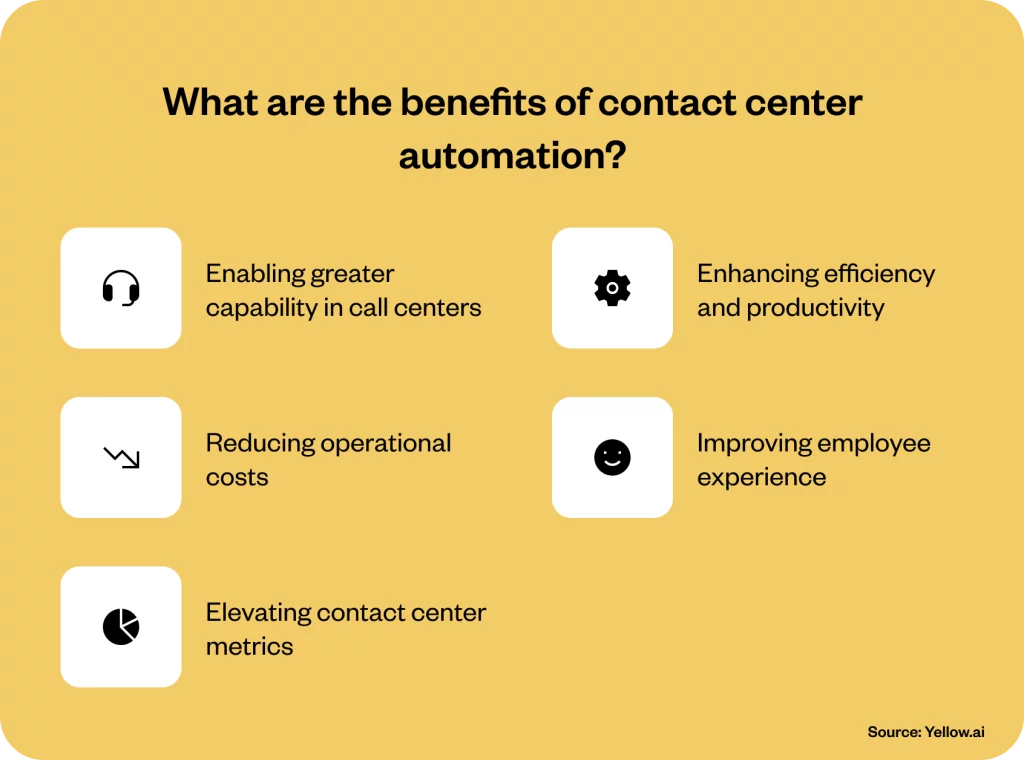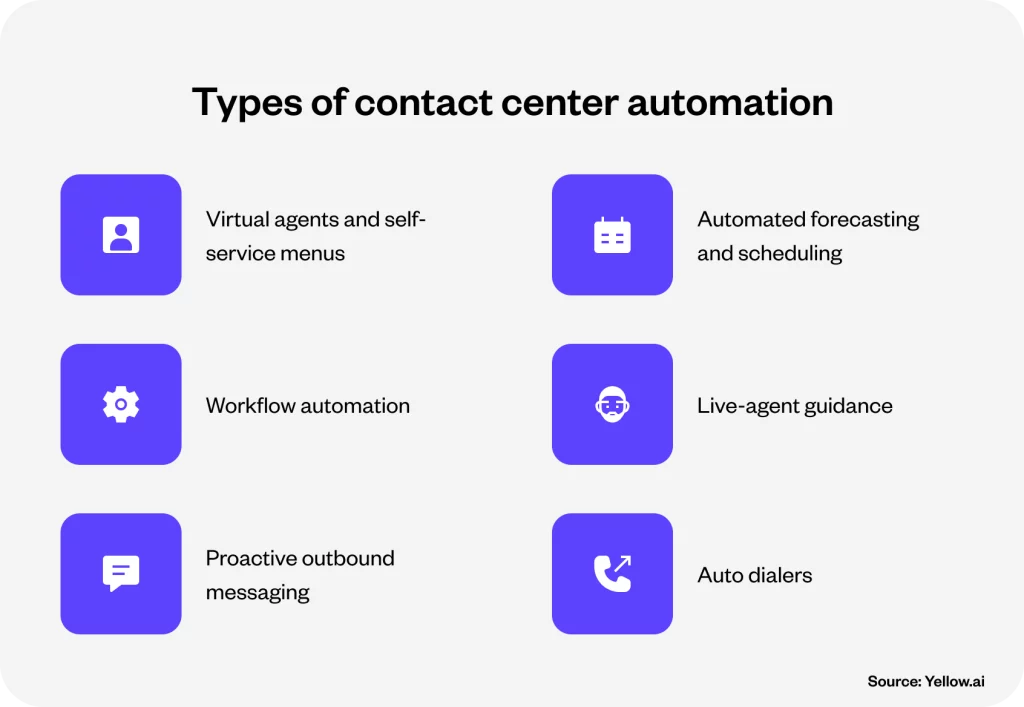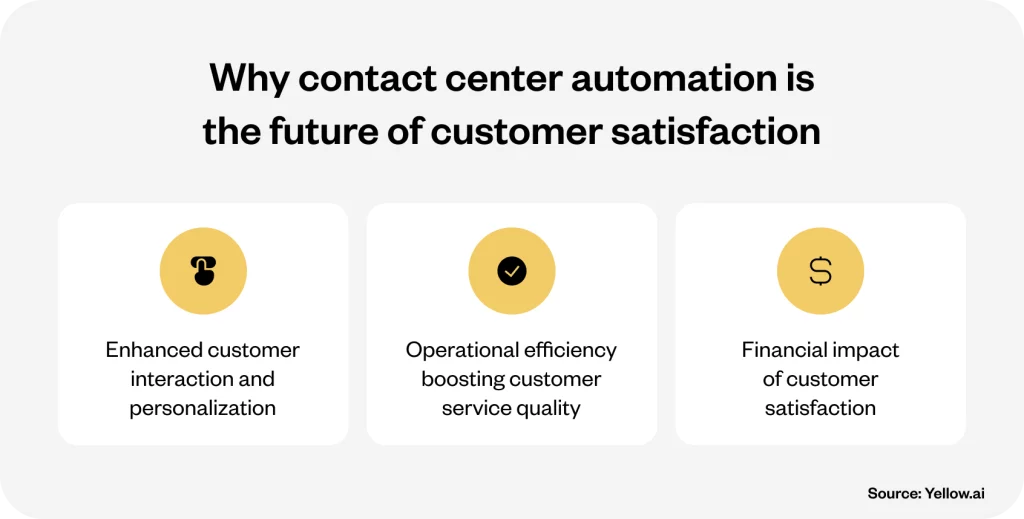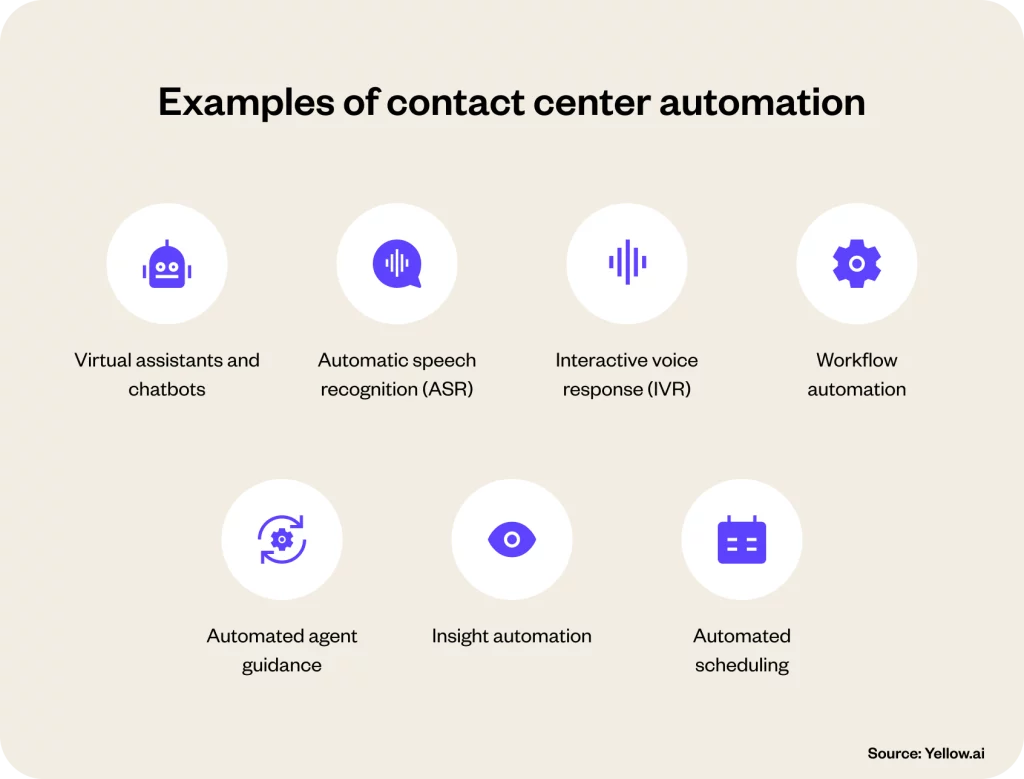Executive summary
Contact center automation is reshaping the landscape of customer service in today’s fast-paced digital world. This article provides an insightful exploration of contact center automation, discussing its vital role, innovative tools, and emerging trends. We delve into what contact center automation means for businesses, highlighting its benefits like enhanced efficiency, cost savings, and improved employee experience. The focus extends to various automation tools – from AI chatbots and automated forecasting to proactive messaging – illustrating how they contribute to superior customer satisfaction.
The dawn of 2024 marks a significant shift in how businesses interact with their customers. Gone are the days of traditional call centers; welcome to the era of contact center automation, where artificial intelligence and machine learning redefine customer service dynamics. This evolution is not just a trend but a strategic pivot, essential for businesses aiming to thrive in a competitive digital marketplace.
Imagine a scenario where customer queries are resolved instantaneously, operational costs are slashed dramatically, and support agents are freed from mundane tasks to focus on complex problem-solving. A 2022 survey revealed an overwhelming majority of contact center leaders are either embracing or planning to integrate automation into their systems. This move towards automation is about reimagining customer service to be more efficient, responsive, and personalized.
The journey towards automation, while promising, requires thoughtful navigation. Identifying the right blend of tasks for automation, integrating AI with a human touch, and maintaining customer empathy are key to a successful transition. The benefits, however, are compelling: reduced response times, 24/7 customer support, and enhanced personalization in customer interactions. Let’s explore the nuts and bolts of contact center automation, its significant advantages, the types of automation, and effective implementation strategies.
Intelligent automation in the contact center
Intelligent automation stands as a beacon of efficiency and innovation in contact centers. This technology revolution is not just about replacing human effort with machines; it’s about enhancing and streamlining the interaction between customers and service providers.
The implementation of intelligent automation revolves around thoughtful integration. It’s about deploying AI-powered virtual assistants for simple, repetitive tasks, thereby freeing human agents to handle complex, customer-centric interactions. Such automation goes beyond just reducing call handle times; it empowers agents with the right tools and information, enabling quicker and more informed decision-making.
1. Chatbots and conversational interfaces: Using Natural Language Processing (NLP) and Understanding (NLU), chatbots and voice assistants have become adept at providing conversational experiences. These tools can comprehend customer queries and respond in a natural, intuitive manner, enhancing customer engagement.
2. Machine learning (ML): ML algorithms play a crucial role in analyzing interaction data. They identify patterns in agent activity, resolutions, and customer feedback, continuously refining the system for greater efficiency and effectiveness.
3. Deep learning neural networks: Taking machine learning to the next level, deep learning neural networks imitate the human brain’s functioning. They are increasingly being used in contact centers to analyze and improve interactions, not only with customers but also in the internal processes and decision-making frameworks.
The future of customer service
Intelligent automation is redefining the future of customer service. It’s an ever-evolving journey towards more personalized, efficient, and responsive customer interactions. By embracing these technologies, contact centers are not just cutting costs or reducing workloads; they are stepping into a new era of customer engagement where every interaction is an opportunity to impress, retain, and grow their customer base.
Businesses looking to stay competitive in the digital age need to look beyond traditional models and embrace the transformative power of intelligent automation in their contact centers. It’s not just an upgrade; it’s a necessity for thriving in the modern, customer-centric market landscape.
What is Contact center automation?
Contact center automation is a term that encapsulates the transformation by integrating cutting-edge technology into the fabric of contact center operations. At its heart, contact center automation is the strategic use of Artificial Intelligence (AI) and Machine Learning (ML) to shoulder tasks that were once the sole domain of human agents.
Imagine a bustling contact center, traditionally powered by the tireless efforts of countless personnel. Now, infuse this image with intelligent systems capable of handling routine inquiries and tasks – that’s contact center automation. It’s not about replacing human touch; instead, it’s about augmenting it. These automated systems deftly handle the repetitive aspects of the job, freeing up agents to focus on more complex, nuanced customer interactions.
The impact of contact center automation is profound and multifaceted. Automating routine tasks frees up agents to focus on more complex and nuanced customer interactions, thereby adding significant value to the customer experience. This transition leads to tangible improvements in key contactcenter metrics like first-call resolution rates and speed to answer. Moreover, the incorporation of AI and ML in contact center automation allows for a continuously adapting environment, ensuring that the contact center’s operations are always aligned with evolving customer needs and preferences. In essence, contact center automation is not just about reducing the workload on human agents; it’s about revolutionizing contact center processes and elevating the customer experience to new heights.
What are the benefits of contact center automation?
Efficiency and customer satisfaction are paramount in today’s world, and contact center automation has emerged as a transformative force. This technological leap is about reshaping the very landscape of customer interaction. From extending capabilities to enhancing agent experiences, automation in contact centers is unlocking new potentials and setting new benchmarks in customer service excellence. Let’s explore the multifaceted benefits it offers, each contributing to a more dynamic, responsive, and cost-effective contact center environment.

1. Enabling greater capability in contact centers
Contact center automation elevates the capability of these critical customer interaction hubs. By integrating automation software, contact centers can extend their service hours beyond traditional working times, providing round-the-clock assistance. It is especially crucial in managing diverse communication channels, such as social media, where customer preferences are increasingly leaning.
With automation, contact centers can effectively maintain an omnichannel presence, ensuring that they are accessible to customers through their preferred mediums, thereby enhancing customer satisfaction and reach.
2. Enhancing efficiency and productivity
Automation in contact centers leads to a significant boost in efficiency and productivity. Tasks that are prone to human error, such as data entry, can be reliably managed by automated systems, minimizing mistakes and streamlining processes. Additionally, automating routine post-call administration allows for meticulous data handling without the time constraints that human operators might face. This increase in accuracy and efficiency directly translates to improved overall productivity of the contact center.
3. Reducing operational costs
One of the most tangible benefits of contact center automation is the reduction in operational costs. Automated resources like FAQs and chatbots can handle a substantial volume of customer queries, reducing the reliance on human agents and thereby cutting down on associated costs. Furthermore, by reallocating human resources to tackle more complex issues, businesses can optimize their workforce, resulting in a more cost-effective operation.
4. Improving employee experience
contact center automation significantly enhances the employee experience. It reduces the time employees spend on repetitive and monotonous tasks, allowing them to focus on more engaging and challenging aspects of their job. This shift not only boosts job satisfaction but also contributes to a lower turnover rate. Empowered by automation, employees can access real-time data-driven insights, aiding them in customer interactions, upselling opportunities, and problem resolution.
5. Elevating contact center metrics
Automation plays a crucial role in improving vital contact center metrics. By speeding up response times and directing customers to the most relevant resources, first contact resolution (FCR) scores and other critical metrics see substantial improvement. It leads to a scenario where employees can concentrate on enhancing customer satisfaction while the technological aspect of the operation focuses on efficiency and speed.
Types of contact center automation
The landscape of contact center automation is diverse, encompassing various tools and technologies designed to streamline operations, enhance customer experiences, and optimize agent performance. Let’s understand the various types of automation that are reshaping contact centers:

1. Virtual agents and self-service menus
Virtual agents powered by AI are revolutionizing the way customers interact with contact centers. They offer intuitive self-service options, handling routine inquiries and providing instant responses. It reduces wait times and improves customer satisfaction.
Self-service menus, including Interactive Voice Response (IVR) systems, allow customers to navigate through options using voice commands or keypad inputs. This autonomy in service not only enhances customer experience but also efficiently routes calls to the appropriate departments or agents.
2. Automated forecasting and scheduling
Forecasting tools in contact centers predict incoming call volumes and schedule agent shifts accordingly. By analyzing historical data and current trends, these tools ensure optimal staffing, reducing both understaffing and overstaffing scenarios.
Scheduling automation also plays a crucial role. It allocates resources based on forecasted needs, ensuring that the right number of agents are available at the right times, thus maintaining service levels without incurring unnecessary labor costs.
3. Workflow automation
Workflow automation streamlines various operational processes within the contact center. It includes tasks like assigning agents to queues, managing customer interactions, and ensuring compliance with service level agreements (SLAs).
By automating these workflows, contact centers can reduce manual errors, increase efficiency, and ensure a consistent quality of service. It leads to improved customer experiences and higher agent productivity.
4. Live-agent guidance
Live-agent guidance systems use AI to assist agents during calls by providing real-time information, suggestions, and support. It includes displaying customer history, recommending responses, and offering guidance on complex issues.
Such systems enhance the capability of agents to handle calls more effectively and empathetically, leading to higher first-call resolution rates and improved customer satisfaction.
5. Proactive outbound messaging
Proactive outbound messaging involves sending automated messages to customers based on specific triggers or events. It can include appointment reminders, service updates, or promotional messages.
By automating these communications, contact centers can maintain regular contact with customers, provide timely information, and reduce the volume of inbound calls, all of which contribute to a more efficient operation.
6. Auto dialers
Auto dialers are tools that automatically dial customer phone numbers, transferring the call to an agent when the customer answers. This technology maximizes agent productivity by eliminating the need for manual dialing.
Different types of auto-dialers, such as predictive, progressive, and power dialers, offer various levels of automation and efficiency. They ensure that agents spend more time talking to customers and less time waiting for connections, thus enhancing the outbound calling process.
Why contact center automation is the future of customer satisfaction
Contact center automation is rapidly becoming a pivotal factor in driving customer satisfaction to new heights. This technology, once perceived as a futuristic concept, is now a tangible reality shaping the way businesses interact with their customers. The future of customer satisfaction hinges on the ability of call centers to adapt to this evolving landscape, integrating automation in ways that enhance the overall customer experience.

1. Enhanced customer interaction and personalization
Automation in contact centers is not just about efficiency; it’s about enriching the customer interaction experience. By utilizing AI and machine learning, call centers can offer personalized experiences at scale. Automated systems quickly gather and analyze customer data, enabling agents to understand customer histories, preferences, and issues in real-time. This level of personalization ensures that customers feel valued and understood, leading to higher satisfaction rates.
Moreover, with advanced technologies like sentiment analysis, contact centers can gauge the emotions and tones of customers, allowing agents to tailor their approach accordingly. This capability is crucial in ensuring that each interaction is empathetic and effective, directly contributing to improved customer satisfaction and loyalty.
2. Operational efficiency boosting customer service quality
Contactcenter automation significantly reduces the response time, ensuring that customer queries are addressed promptly. Fast and efficient service is a crucial driver of customer satisfaction. Automated systems like chatbots and IVR provide immediate answers to common queries. As a result, they reduce customer wait times and allow human agents to handle more complex issues.
Furthermore, the reduction in handle time and the ability to manage higher call volumes without compromising service quality means customers receive attention when they need it most. This responsiveness is crucial in today’s fast-paced environment, where customers expect quick resolutions to their inquiries.
3. Financial impact of customer satisfaction
The correlation between customer satisfaction and a company’s financial performance is undeniable. Satisfied customers are more likely to be repeat customers, and they often spend more. Research indicates that customers who rate their service experience highly are over twice as likely to make another purchase. In terms of revenue, providing excellent customer service through efficient contact center operations can safeguard and even increase a company’s revenue streams.
By implementing contact center automation, businesses not only elevate customer satisfaction but also position themselves for greater financial success. With the potential risk of losing a significant percentage of revenue due to poor customer experiences, prioritizing automation becomes essential for maintaining and growing a customer base in a competitive market.
Examples of contact center automation
The implementation of automation in contact centers has opened doors to numerous innovative solutions that streamline operations and enhance customer experiences. These examples of automation not only reflect technological advancements but also indicate how they can be practically applied to improve efficiency and customer satisfaction. Let’s delve into some key examples:

1. Virtual assistants and chatbots
Virtual assistants and chatbots are at the forefront of automation in contact centers, offering immediate assistance to customers. These AI-driven tools engage customers based on their browsing behavior, initiating conversations and providing solutions in real-time. They are versatile and can be integrated across websites, social media platforms, and mobile apps.
The ability of these systems to escalate more complex issues to human agents while independently handling routine inquiries exemplifies the synergy between AI and human intervention. This approach ensures customers receive timely support.
2. Automatic speech recognition (ASR)
ASR technology allows contact centers to “listen” to verbal customer responses during calls. When paired with Interactive Voice Response (IVR) systems, ASR becomes a powerful tool for directing calls and collecting customer information without human involvement.
The integration of ASR in contact centers streamlines call handling, enhances customer data collection, and improves the overall efficiency of call routing and response.
3. Interactive voice response (IVR)
IVR systems are automated solutions that guide customers to the right department using pre-recorded messages and speech recognition. This technology manages customer calls effectively, keeping them engaged and reducing the likelihood of repeated calls.
IVR systems also gather essential customer information, such as language preferences and account details, contributing to a more personalized customer service experience.
4. Workflow automation
Workflow automation in contact centers involves automating administrative tasks, such as filling post-call forms and updating customer databases. This automation spares agents from time-consuming paperwork, allowing them to focus more on customer interactions.
Such automation also ensures accuracy in data management and provides a streamlined process for tracking customer interactions, enhancing the overall operational efficiency of the contact center.
5. Automated agent guidance
Automated agent guidance uses AI analytics to offer real-time coaching and insights to agents. This technology assists agents in adhering to service standards and legal compliance, providing prompts and suggestions during customer interactions.
By incorporating customer feedback and compliance monitoring, automated agent guidance helps in designing effective training and performance improvement strategies for agents, reducing turnover and enhancing service quality.
6. Insight automation
Insight automation ensures that feedback and issues reported by customers are promptly communicated across relevant departments. This approach accelerates response times to customer issues and fosters continuous improvement in products and services.
By automating the communication loop between customer service and other departments, insight automations contribute to a more cohesive and responsive organizational approach to customer feedback.
7. Automated scheduling
Automated scheduling in contact centers dynamically assigns agents based on demand and skill sets, eliminating the need for manual scheduling. Besides saving time, it also ensures optimal staffing for different times and needs.
Prediction-based software complements automated scheduling by analyzing past data to forecast future demand, allowing for more efficient and proactive staff allocation.
How Yellow.ai’s AI chatbots aid in next-gen contact center automation?
Yellow.ai stands at the forefront of automating contact centers and revolutionizing customer service through its cutting-edge AI chatbot technology. Here’s how Yellow.ai can significantly uplift your contact center’s capabilities, backed by its impressive technological prowess and extensive experience:
1. Robust no-code platform
Yellow.ai’s platform is designed for both ease and sophistication. Its no-code environment allows businesses to create and deploy AI chatbots without needing deep technical expertise. This feature democratizes access to advanced AI technology, enabling businesses of all sizes to benefit from automation.
2. Vast conversational intelligence
With experience in handling over 12 billion conversations, Yellow.ai’s chatbots are enriched with a depth of conversational intelligence that is unmatched. This vast database of interactions ensures that the AI is well-equipped to handle a wide range of customer queries with nuanced understanding and precision.
3. Multilingual and multidialectal reach
Understanding the global nature of businesses, Yellow.ai offers chatbots that can communicate in over 135 languages and dialects. This capability allows your business to transcend geographical and linguistic barriers, offering a localized customer service experience to a global audience.
4. Advanced AI and machine learning capabilities
Yellow.ai’s chatbots are powered by state-of-the-art AI and machine learning algorithms. These technologies enable the chatbots to learn from each interaction, continuously improving their accuracy, response quality, and effectiveness in handling complex customer queries.
5. Seamless integration and scalability
The platform’s ability to integrate seamlessly with existing business systems ensures that the chatbots work in harmony with your current digital ecosystem. This integration extends to various CRM systems, databases, and other operational tools. Yellow.ai’s solutions are designed to scale alongside your business growth, ensuring that the quality of customer service remains consistent even as interaction volumes increase.
6. Real-time analytics for informed decision-making
The platform provides real-time analytics and insights, enabling businesses to track customer interactions, measure chatbot performance, and gain valuable insights into customer behavior and preferences. These analytics play a crucial role in shaping customer service strategies, ensuring they are data-driven and customer-centric.
By leveraging Yellow.ai’s advanced AI chatbot technology, businesses can transform their customer service operations into efficient, responsive, and highly personalized customer engagement centers.
Embracing contact center automation: A conclusion
Contact center automation, fueled by advancements in AI and machine learning, is not just a technological upgrade; it is a strategic redefinition of customer engagement. As businesses worldwide embrace this paradigm, the future of customer service shines brighter, promising unparalleled efficiency, personalized experiences, and unwavering customer satisfaction. The evolution of contact centers into automated, intelligent hubs of customer interaction is a testament to the relentless pursuit of excellence in customer service. In this digital age, where customer expectations continuously soar, automation stands as the key to unlocking new potentials in customer service, ensuring businesses not only meet but exceed these evolving demands.
Frequently asked questions (FAQs)
What is contact center automation?
Contact center automation refers to the use of advanced technologies like AI, machine learning, and robotic process automation (RPA) to streamline and enhance customer service operations. It encompasses various tools and strategies designed to automate repetitive tasks, manage customer interactions, and improve the overall efficiency and effectiveness of contact centers. This automation enables businesses to deliver faster, more personalized customer service, often leading to increased customer satisfaction and loyalty.
What is RPA in a contact center?
RPA, or Robotic Process Automation, in the context of a contact center, involves using software robots to automate mundane and repetitive tasks. These tasks can range from data entry and form filling to more complex actions like customer query categorization and routing. RPA helps free up human agents to focus on more nuanced and complex customer interactions, thus enhancing the overall quality of customer service.
How do you automate a contact center?
Automating a contact center involves integrating various technological solutions like AI-driven chatbots, IVRs (Interactive Voice Responses), and machine learning algorithms. These technologies can handle routine inquiries, direct customers to the appropriate resources, and even provide real-time assistance to agents. The key to successful automation lies in finding the right balance between automated services and the human touch to ensure that the customer experience remains personal and engaging.
What are the use cases of automation in contact centers?
Key use cases of automation in contact centers include customer self-service through chatbots and IVRs, automated customer feedback collection, predictive analytics for better customer engagement, and real-time agent assistance. Other uses involve workflow automation for internal processes, such as scheduling and performance analytics, to enhance operational efficiency.
What are the benefits of automated customer service?
Automated customer service offers numerous benefits, including increased efficiency, reduced operational costs, and the ability to provide 24/7 customer support. It also leads to improved customer satisfaction through faster response times and more accurate, personalized service. Additionally, automation can enhance employee satisfaction by reducing their workload on routine tasks, allowing them to focus on more challenging and rewarding aspects of customer service.
How is AI used in contact centers?
AI in contact centers is used for a variety of purposes, including powering chatbots to handle routine customer queries, using natural language processing to understand and respond to customer needs, and employing machine learning for predictive analytics to anticipate customer issues and needs. AI also assists agents in real-time decision-making, offering them insights and information during customer interactions to improve the quality of service.
















